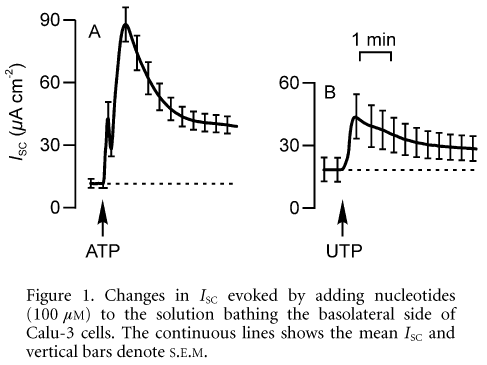Previous studies of the human airway-derived Calu-3 cell line suggested that P2Y1 receptors were the only phospholipase C-coupled P2Y receptor subclass present (Communi et al. 1999). However, experiments in which nucleotide-evoked changes in [Ca2+]i were recorded from cells grown on permeable supports, suggested that at least two P2Y receptor subtypes are present and indicated that these were confined to the basolateral membrane (Clunes et al. 2002). We have therefore now explored the effects of apical and basolateral nucleotides upon the short-circuit current generated by Calu-3 cells cultured (10 days) on permeable membranes.
Basolateral ATP and UTP (100 mM) increased ISC although the integrated response to UTP was only 33.0 ± 14.5 % of that evoked by ATP (Fig. 1). This contrasts with data from the experiments in which [Ca2+]i was measured, which indicated that basolateral ATP and UTP acted with equal efficacy (Clunes et al. 2002). Moreover, the electrometric response to ATP consists of an initial transient followed by a second, slower component, whilst UTP evokes only a monophasic increase (Fig. 1). Experiments in which cells were stimulated with different concentrations of nucleotides showed that the EC50 values for ATP and UTP were 48.5 ± 18.1 and 19.8 ± 9.5 mM, respectively. Cross-desensitisation experiments using concentrations of ATP and UTP known to produce essentially complete (> 95 %) autologous desensitisation, showed that ATP-prestimulated cells retained little (22.4 ± 5.5 %, n = 11) sensitivity to UTP but that UTP-stimulated cells maintained substantial (59.9 ± 4.0 %, n = 12, P < 0.05, unpaired t test) sensitivity to ATP. At least two P2Y receptor subtypes are thus present on the basolateral membrane. ATP and UTP (both 100 mM) also increased ISC when added to the apical solution, but the integrated responses were smaller than the response to basolateral ATP (ATP: 33.9 ± 8.4 %, n = 5; UTP: 23.8 ± 9.0 %, n = 5). Cross-desensitisation experiments indicated that multiple P2Y receptor subtypes were also present in this membrane. Rather than simply expressing P2Y1 receptors (Communi et al. 1999), multiple P2Y receptor subtypes seem to be present in both the apical and basolateral membranes of Calu-3 cells, although complementary studies (Clunes et al. 2002) suggest that only the basolateral receptors are coupled to changes in [Ca2+]i.
The authors thank The Wellcome Trust for a Prize Studentship (L.A.C).

